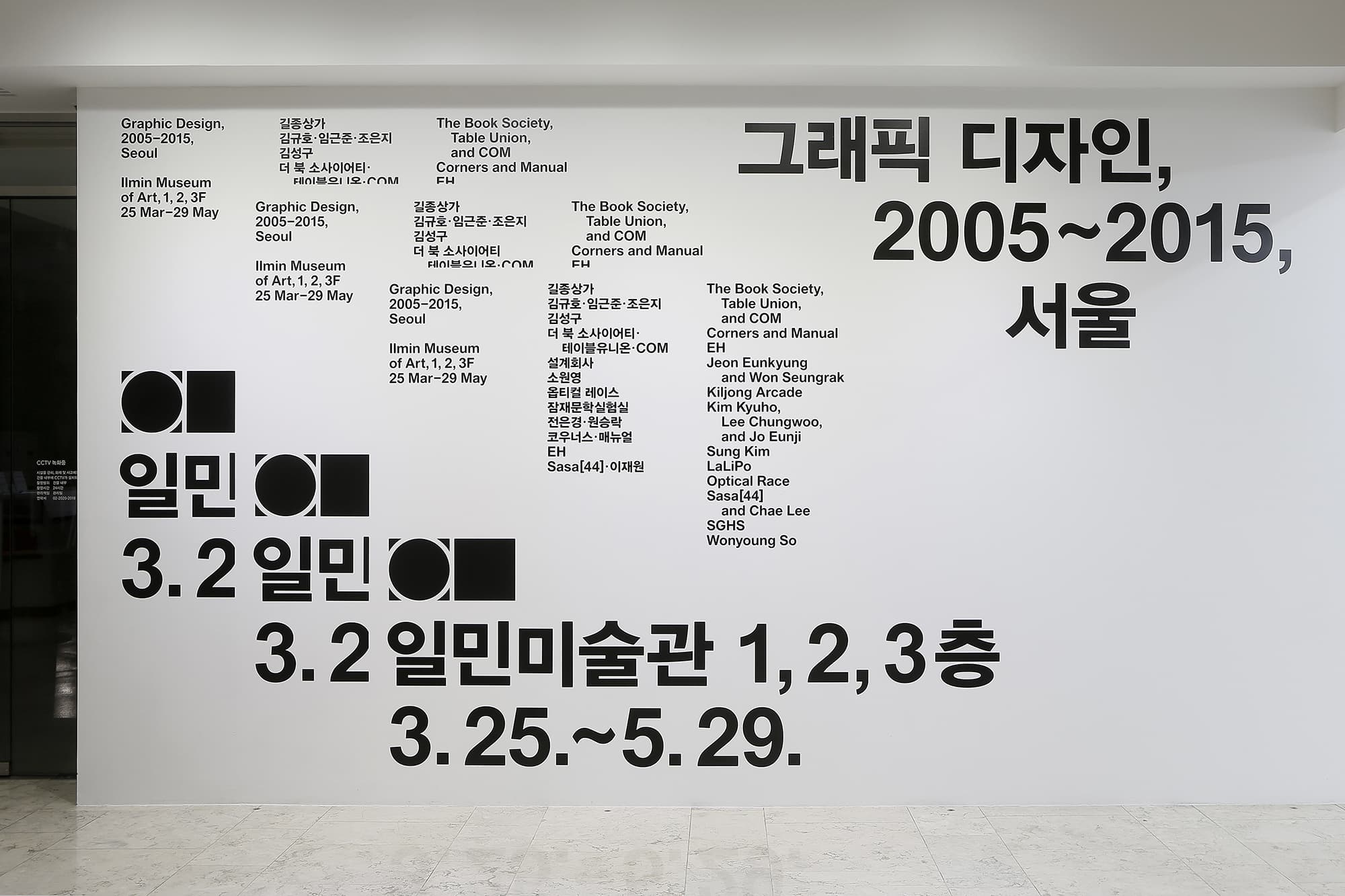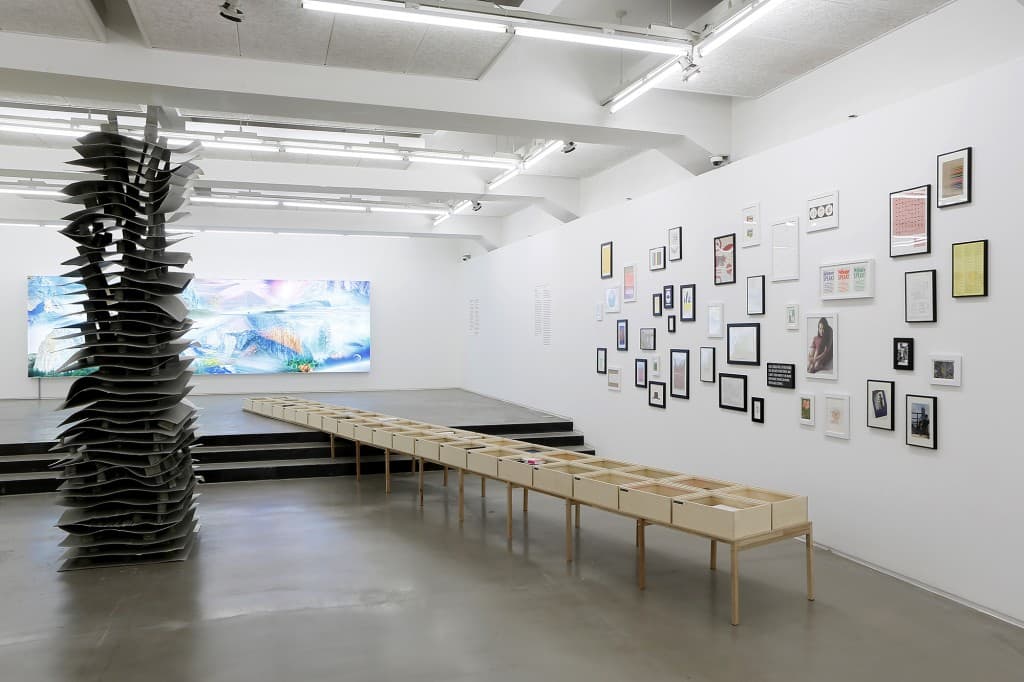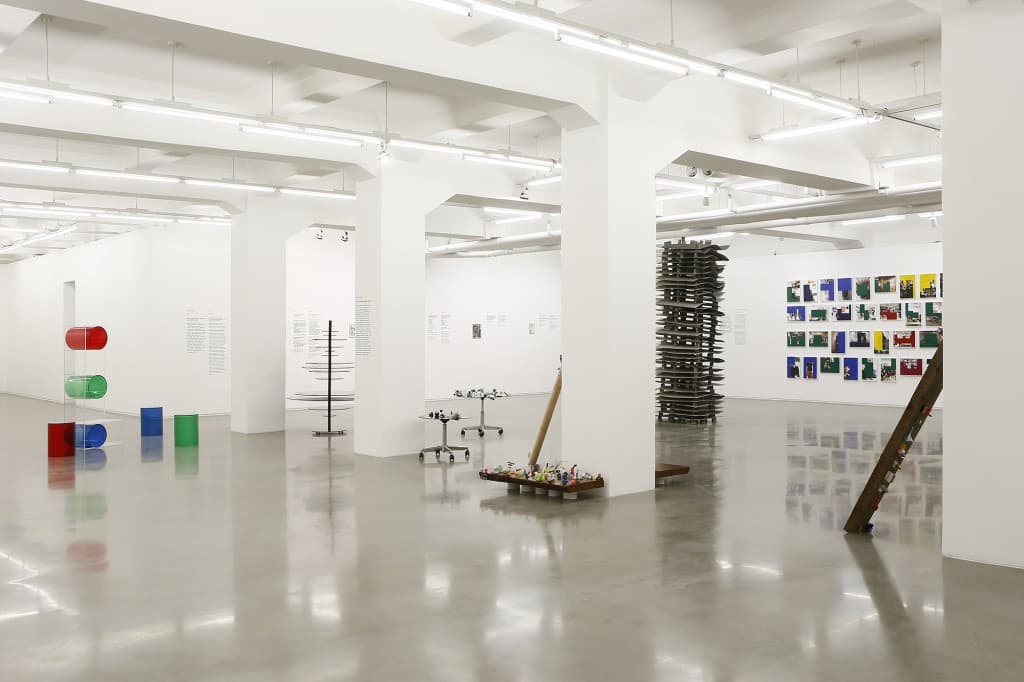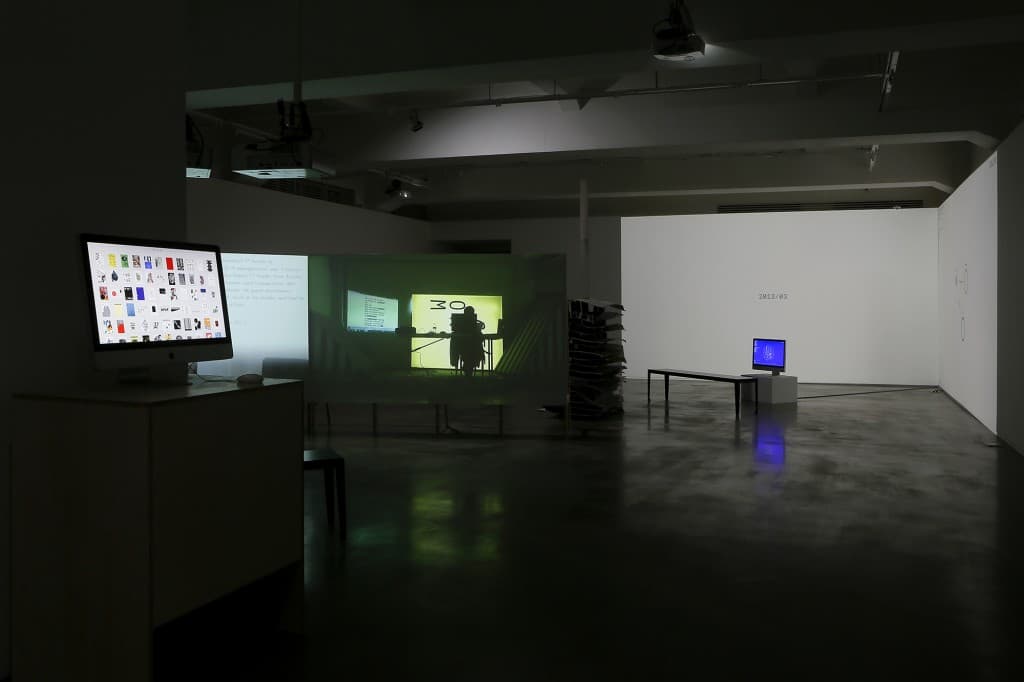그래픽 디자인은 시각 매체에 텍스트와 이미지를 배치해 내용을 전달하는 기술과 실천을 가리킨다. 2005년은 호주제에 대해 헌법 불합치 선고가 내려진 해이고, 2015년은 간통죄가 위헌으로 판결된 해다. 그리고 서울은 가로 36.78 km, 세로 30.3 km에 이르는 대한민국의 도시다. «그래픽 디자인, 2005~2015, 서울»은 이 항목들을 직설적이지만 다소 불안정하게 연결한다.
이 전시는 2005년 이후 10여 년간 서울에서 이루어진 그래픽 디자인 전반을 공평하게 다루지 않는다. 이를테면 기업 연례 보고서나 통신 회사 안내서, 금융 상품 광고 등은 이곳에서 찾아볼 수 없다. 대신, 전시는 문화 영역을 중심으로 활동한 소수 개인 디자이너의 작업에 집중한다. 흔히 ‘소규모 스튜디오’라 불린 그들은 출판, 미술, 사진, 건축, 연극 등 인접 영역에서 활동하며 영향력을 넓혀갔다. 물론 이전에도 작은 스튜디오는 있었고, 문화 영역에도 언제나 그래픽 디자인은 존재했다. 그러나 다른 점이 있다. 2005년 무렵부터 소단위 조직은 디자인 기업의 대안으로서 더 적극적 의미를 띠게 되었다. 그리고 흔히 그런 스튜디오에서는 전시회 홍보물이나 인문 도서 같은 저예산 문화 영역 작업이 ‘상업적’ 정규 사업을 보완하거나 포트폴리오의 구색을 맞추기 위한 장식이 아니라 (자의건 타의건) 거의 유일한 활동이 되었다. 그런데 흥미롭게도, 그런 ‘마이너’한 작업이 이전 시대보다 뚜렷한 가시성을 띠면서 디자인계와 문화 예술계에 큰 영향을 끼치기 시작했다. 그러므로 이처럼 한정된 소수의 활동에 집중하는 데는 분명한 의의가 있지만, 그렇다 해도 그들이 해당 시기 서울의 그래픽 디자인을 대표한다고, 매끄럽게 말할 수는 없다. 전시 제목이 쉼표와 물결표로 다소 불안정하게 연결된 것은 그런 이유에서다.
«그래픽 디자인, 2005~2015, 서울»은 그래픽 디자인 전시에서 쉽게 떠올릴 만한 풍경을 제공하지 않는다. 간단히 말해, 이곳에는 포스터나 책, 잡지나 로고타이프 등 익숙한 물건이 거의 없다. 쉽사리 버려지는 일회성 인쇄물 도서관(‹불완전한 리스트›)을 제외하면, 그것들은 실물이 아니라 데이터베이스로 정돈되거나(‹101개 지표›), 초 고해상도 사진으로 환원되거나(‹IMG›), 정체가 모호한 물체로 변형되거나(‹3차원 세계의 화답›), 낱말 단위로 해체 · 재구성되거나(‹기법 /// 누적된 선언으로 도출되는 기록이 물리적 방식으로 종이에 나타난다.›), 아예 3개 층 전시장을 관통하는 기둥이 되어 나타난다(‹빌딩›). 그래픽 디자인은 디자이너의 사회관계를 중심으로 파악되기도 하고(‹스몰 월드›), 시각 문화의 역사와 연관해 설명되기도 하며(‹걸작이로세!›), 세계사와 결부된 사건이 되기도 한다(‹33›). 그런가 하면, 전시는 그래픽 디자이너의 생산수단과 무의식 사이에 존재할 법한 풍경을 상상해 보기도 하고(‹요세미티 산에서 외골수 표범이 흰 사자와 우두머리 호랑이를 뛰어넘는다›), 디자인 생산물이 파편화된 모습으로 이어 가는 사후 세계를 그려 보기도 한다(‹그2서, 리소 프린트 숍›, ‹일백일자도›).
이런 연출을 두고 누군가는 지나치게 에둘렀다고 생각하거나 필요 이상으로 멋을 부렸다고 느낄 수도 있다. 그러나 어쩌면 그래픽 디자인 전시에 관해서는 이처럼 ‘해석된 풍경’을 보여 주는 것이 오히려 정직하고 직접적인 방법일지도 모른다. 실제 생활 공간이 아닌 미술관에서, 그래픽 디자인을 참으로 ‘있는 그대로’ 보여 줄 방법은 없다. 그런 목적으로 행해지는 활동이 아니기 때문이다. 그래픽 디자인은 자기 충족적인 활동이 아니라 내용과 맥락에 의존하는 활동이기 때문이며, 또한 협력자와 사용자에 의해, 그들이 더해 주는 시각과 의미에 의해 확장, 설명, 변환, 향유되는 예술이자 언어이기 때문이다.
지금은 2016년이다. 11년 전 서울에서는 붕가붕가레코드 로고가 그려졌고 모다페 2005 포스터가 인쇄되었다. 바로 1년 전 서울에서는 그래픽 디자이너 두 명이 동성애자를 위한 첫 서점을 열었다. 이 모두는 이미 어제의 세계가 되었다. 늘 그렇듯, 우리에게는 내일이 남았다.
참여작가
길종상가, 김규호 · 임근준 · 조은지, 김성구, 더 북 소사이어티·테이블유니온·COM, Sasa [44] · 이재원, SGHS설계회사, 소원영, 옵티컬 레이스, EH, 잠재문학실험실, 전은경 · 원승락, 코우너스 · 매뉴얼
장소
일민미술관 1, 2, 3 전시실
주최
일민미술관
전시기획
김형진, 최성민
관람료
일반: 성인 5,000원 학생 4,000원
신문박물관 통합권: 성인 6,000원 학생 4,500원
단체(20인 이상): 성인 4,000원 학생 3,000원
→ 할인 및 무료 관람 혜택 상세 내용 바로가기(https://ilmin.org/kr/visit/visit-information/)
연계된 프로그램으로 바로 가기(https://ilmin.org/kr/program/graphic-design-program/)
Graphic design is an art and practice of combining text and images in visual media to communicate content and meaning. 2005 is the year when the patriarchal family registration system was found inconsistent with the constitution in Korea, and 2015 is when adultery was ruled unconstitutional. And Seoul is a 36.78 km wide, 30.3 km long city in South Korea. Graphic Design, 2005–2015, Seoul connects them literally, but in a rather unsettled way.
This exhibition covers graphic design in Seoul from the last decade, but not fairly. Corporate annual reports, telecommunication company brochures, or financial product advertisements are not to be found here. Instead, it focuses on a few individual designers and their work in the cultural sector. Often called “small studios,” these practices expanded their operation into adjacent fields, including publishing, art, photography, architecture, and theater. Surely, there had been small studios before, and graphic designers had always worked in the cultural sector. But there are differences. Since around 2005, the intimate-scale practice began to be seen as a positive alternative to large firms. And for those small studios or workshops, low-budget, cultural-area projects such as printed matter for an art exhibition or a narrow-readership publication came to be—whether by choice or by force—almost the only source of work, not a fun deviation from regular, “commercial” projects. Interestingly, however, such minority work began to gain visibility, exerting influence in design communities as well as in related cultural fields. Focusing on the work of the limited group of people, therefore, is certainly justifiable, although it would be hard to say that it represents graphic design in Seoul during that period. And that might be a reason for the slightly uneasy title, where the commas and the dash work as rather insecure connectors.
Graphic Design, 2005–2015, Seoul may not provide a familiar view of a graphic design exhibition: it would be hard to find the usuals, such as posters, books, magazines or logotypes on display. Except for a library of ephemera (An Incomplete List), the work of graphic designers in this exhibition are not presented in actuality, but instead organized in a database (101 Indexes), reduced to a series of hyper-fidelity photographs (IMG), transformed to obscure objects (Three Dimensional World Replies), deconstructed and recomposed to new texts (Features /// Emanated records by the cumulative manifest appear on a paper in a physical way.), or turned to a column throughout the three floors of galleries (Building). It is mapped out as the designers’ social relations (Small World), explained in terms of a history of visuality (What a Masterpiece!), or linked to some timelines of world history (33). Meanwhile, there is an imaginary landscape that might be found in between some graphic designers’ means of production and their unconsciousness (A Maverick Leopard Jumps Over the Snow Lion and the Capitan Tiger in the Mountain Yosemite), and previews of the products’ potential afterlives, continued in their fragments (One Hundred One Letters).
Some might find this approach too detached, or pretentious. For a graphic design exhibition, however, this kind of “interpreted presentation” might in fact be a more direct and honest way of dealing with the subject. Within a white cube isolated from everyday spaces, it is nearly impossible to show the products of graphic designers’ work “as they are,” because they are not meant for it. Because graphic design is not a self-contained activity, but is contingent on the content and the context; because it is an art and a language always expanded, explained, transformed, and enjoyed by the designers’ collaborators and the design’s users—by the perspectives and the meanings they bring in.
Today is 2016. Eleven years ago in Seoul, the BGBG Record logo was drawn and the Modafe 2005 poster was printed. And just last year, two graphic designers opened the first gay bookstore in the city. All these now belong to the past; and as always, we have tomorrow.
Organized by
Ilmin Museum of Art
Curated by
Kim Hyungjin, Min Choi
Venue
Gallery 1, 2, 3
Artists
Kiljong Arcade, Kim Kyuho·Lee Chungwoo·Jo Eunji, Sung Kim, The Book Society·Table Union·COM, Sasa[44] and Chae Lee, SGHS, Wonyoung So, Optical Race, EH, LaLiPo, Jeon Eunkyung·Won Seungrak, Corners and Manual
Go to the liked program(https://ilmin.org/kr/program/graphic-design-program/)





